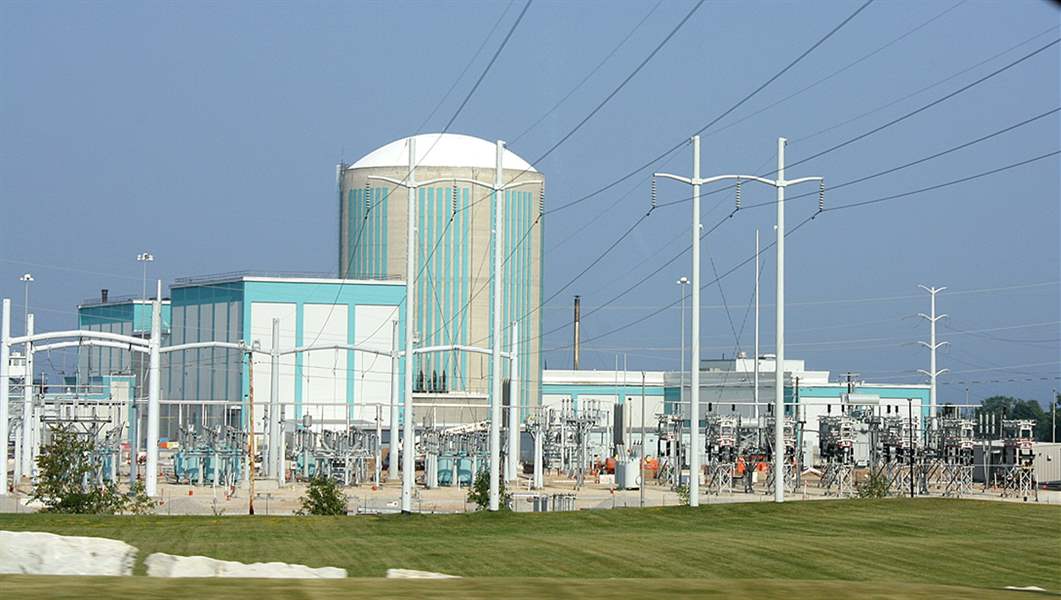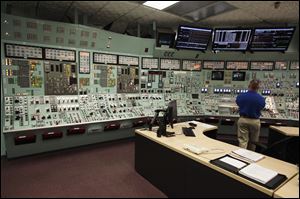
Nuke closures have impacted local economies, changed community character
5/7/2018
Kewaunee Nuclear Generating Station, 27 miles southeast of Green Bay, which ceased operations in May of 2013.
On some of America’s most idyllic shorelines between Vermont and California lie several behemoths of the past, shuttered nuclear power plants closed prematurely because they could no longer compete in electricity markets upended by record-low natural gas prices or because they had technical issues that made them too expensive or scientifically challenging to repair.
Six high-profile closures have occurred in the past five years, the largest wave of shutdowns among the modern fleet of nearly 100 commercial-scale nukes.

Kewaunee Nuclear Generating Station, 27 miles southeast of Green Bay, which ceased operations in May of 2013.
Right behind them are 12 more scheduled to be closed unless a buyer or bailout emerges, including the Davis-Besse, Perry, and two Beaver Valley nuclear plants now owned by a FirstEnergy Corp. subsidiary, FirstEnergy Solutions. In all, that means 18 plants — a fifth of what many people used to see as a cornerstone industry of America’s energy future and a key ally in the global fight against climate-altering greenhouse emissions — have been closed since 2013 or will be closed over the next seven years.
RELATED CONTENT: Fate of Davis-Besse nuclear plant looms over Oak Harbor
Their stories vary. But almost without exception, such plants go from welcome community partners to unwanted guests as they continue to take up large swaths of land along some of the nation’s prime waterfront real estate for decades.
It’s often some of the most gorgeous land, too, along exceptional bodies of water known for their beaches, marshes, and other types of shoreline habitat supporting anything from bald eagles to great blue herons and snowy egrets to Florida’s endangered manatee. It’s land that communities would love to make productive again but can’t do anything about it until the radioactive fuel inside the plants has decayed enough for the decommissioning process to end.
David Hardtke is a farmer and town board chairman of Carlton, Wis., a community of 1,067 where the mothballed Kewaunee nuclear plant is based. He lived in the area when the Kewaunee plant went online in 1974. It ceased operations in May, 2013, and — in the five years since — the town has experienced the predictable dip in its housing market and endured the type of economic hardships common to other communities when nuclear plants close.
“The sad thing is we have nuclear waste sitting on 2.5 miles of prime waterfront land. That's what is going to hurt us. You can't develop that land. It's going to come back and haunt us in the future,” Mr. Hardtke said.
“It’s fine when it’s running. But when it goes down, it just takes up valuable space,” he said, adding that the plant has become an eyesore. “We’re stuck with that mess.”

The control room at the Crystal River Nuclear Plant in Crystal River, Fla., in 2011. After the plant closed, the community became a tourist destination for manatee lovers. “We were lucky to transition to something," said Dave Burnell, Crystal River city manager.
He said he would never advise a community to host a power plant unless it realizes how long it’ll take to decommission it — which, in the case of Kewaunee, is expected to take 60 years.
Carlton is likely going to have one of the softer transitions. The town has made an agreement with the plant’s owner, Dominion Generation, to continue making payments of $325,000 a year to it for a decade.
South of Kewaunee is the mothballed and partially decommissioned twin-reactor Zion nuclear complex in Zion, Ill., on the picturesque Lake Michigan shoreline near the Wisconsin border.
Unlike the current wave of closures, the two Zion reactors were taken out of service 20 years ago on Feb. 13, 1998 — a year after an operator inserted Unit 1’s control rods too far and failed to withdraw them without following established procedures.
But Zion’s two decades of post-closure experience shows how deep-rooted a community’s problems can become and how much its character can change when the lights go out at a nuke plant.
“It’s been absolutely devastating for our community,” Zion Mayor Al Hill said. “We got clobbered on the tax base.”
During its heyday, the complex generated $19 million a year in tax revenue for Zion’s two school districts, its local government, its library district, park district, and other services. Now, all share $1 million — but schools especially have become cash-strapped.
The school districts have raised taxes, but have slid backward in test scores. The community exodus killed property values, led to large reductions in police and fire staffing, and more crime. Property values plunged, and Zion transformed itself to a low-income community where only 3.8 percent of Lake County’s population lives but 35 percent of the county’s low-income housing vouchers are used.
Sixty-two percent of Zion’s housing units are now rentals — three times the average of similar Chicago-area communities.
“My advice to anyone there [in Ohio and Pennsylvania] is you’d better start planning now,” Mr. Hill said.
Communities such as Oak Harbor, Perry, and Shippingport, Pa., that have been highly dependent on revenue from their respective FirstEnergy Solutions nuclear plants will find it’s hard to attract interest when schools struggle, crime increases, housing values go down — and, on top of it, the best real estate has radioactive waste, he said.
“That’s pushing a huge rock up a hill, man,” Mr. Hill said.
Zion and other communities blame the federal government for failing to haul away spent nuclear reactor fuel, the only material in civilian hands classified as high-level radioactive waste. Theirs is stored in the spent fuel pools, which Mr. Hill said aren’t going away anytime soon.
The Supreme Court ruled in 1998 the government had a contractual obligation to put all of the high-level waste into a national repository because of the Nuclear Waste Policy Act that Congress passed in 1982. But Nevada’s Yucca Mountain — the chosen site — has not been developed enough to take waste, and no completion date is in sight.
“We have 274 acres of Lake Michigan shoreline we can't develop,” Mr. Hill said. “Because they reneged on that contract, we're sitting here stuck with spent fuel rods. Who's going to invest in a lakefront with nuclear fuel rods?”
He said Ohio and Pennsylvania officials should absolutely be concerned about the character and charm of their respective communities being put at risk.
“I’m guessing it's going to change it tremendously. It's changed ours,” Mr. Hill said. “We’re sucking wind right now.”
Although other communities have far less post-closure experience, they echo many of Mr. Hill’s concerns.
“We certainly saw a spike in houses for sale on the heels of the closure of the plant,” said Michelle Pong, town administrator of Vernon, Vt., where the Vermont Yankee nuclear plant that closed at the end of 2014 is located.
As host community, Vernon’s 2,100 residents were eligible for a 25 percent tax credit on their municipal and educational taxes. And the average salary of Vermont Yankee’s 600-member work force was $105,000 a year.
That’s all gone.
But even with budgets cut and taxes going up, Vermonters are a hardy bunch. Many come from multigenerational families fighting off the temptation to leave. Others have taken jobs in other parts of New England and become “weekend parents who travel great distances to work at other power plants,” Ms. Pong said.
At the same time, the area is getting more affluent professionals buying up rural land and taking a shot at farming, or opening up small businesses.
“We were here a long time before Vermont Yankee was and will be for a long time afterward,” Ms. Pong said. “We’re going to move forward. There’s a lot of community spirit to pull together.”
Patrick Moreland, assistant town manager of nearby Brattleboro, Vt., said the diversity of Vermont’s economy is helping the region get through this rough patch.
“There's been a lot of energy and work done in growing the economy in many ways. There are a lot of exciting things going on. There's definitely reason to be hopeful,” Mr. Moreland said.
At the Crystal River 3 nuclear plant near Crystal River, Fla., a small Gulf of Mexico shoreline community became more of what it was all along, a tourist destination for manatee lovers.
“We are no longer a bedroom community for the nuclear plant. We are now a tourist community,” Dave Burnell, Crystal River city manager, said. “We were lucky to transition to something.”
Crystal River and South Florida have long been established as favorite wintering destinations for the lovable sea cows, which will venture out into deeper water during the summer but stay within about a mile of the shoreline once the water temperature drops.
Although a marketing campaign on behalf of manatees had been in effect for years, it was intensified worldwide once the owner of the Crystal River 3 nuclear plant, Duke Energy, announced on Feb. 20, 2013, that it had given up trying to repair the plant’s cracked containment shell. The cracks stemmed from a refueling outage that began on Sept. 26, 2009, when a large hole was cut into the containment structure to get new steam generators inside. The owner tried to repair the damage, but eventually decided it was too costly.
“Our city is lucky because we've had the growth of manatee tourists,” Mr. Burnell said. “They’ve created lower-paying jobs, but at least they’re jobs.”
Home property values sank, especially the more expensive ones. Mr. Burnell said he knows of one man who sold his house for $1.1 million when relocating for another job, then buying it back for less than half that amount when he returned to the area.
Two hurricanes after the 2008 financial crisis haven’t helped.
Crystal River Councilman Michael Gudis said the plant’s closure “was a disaster as far as our local economy was concerned.”
Much of the construction trade left after Crystal River 3 was shut down because the housing market had gone soft, he said.
“Now that our economy's picking up, we're having trouble finding skilled people to do the jobs,” Mr. Gudis said. “Obviously, a lot of people lost their jobs and things were bad for a while. It's a wonderful place to live, but there aren't that many jobs that pay well.”
Mr. Burnell agrees the closure changed Crystal River’s character — and the way it now views a structure that was the cornerstone of the community’s economy when it was operating.
“It goes from being an operating nuclear plant to a nuclear waste holding facility,” he said.
Meanwhile, anxiety is building in Oak Harbor, Ohio, a charming community that has relied on tax revenue generated by Davis-Besse for more than 40 years.
Bob Cook, Oak Harbor Hardware Store employee, said “everything’s in limbo” now that FirstEnergy has done its final refueling, and the two-year countdown has begun.
“We have to go into it with our eyes open,” Mr. Cook said, echoing the hope others have that a buyer will emerge. “I just hope there’s enough resilience in the community in which people want to stay.”
Contact Tom Henry at thenry@theblade.com, 419-724-6079, or via Twitter @ecowriterohio.